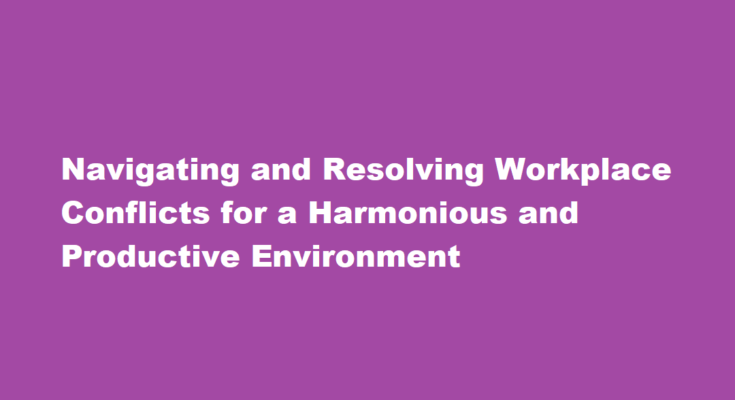Introduction
Workplace conflicts are an inevitable aspect of professional life, stemming from differences in personalities, perspectives, and goals. Effectively navigating and resolving these conflicts is essential to maintaining a harmonious and productive work environment. Addressing conflicts with empathy, open communication, and a problem-solving approach can not only mitigate negative outcomes but also foster stronger team dynamics.
Understanding the Root Causes
Before addressing conflicts, it’s crucial to comprehend their underlying causes. Conflicts can arise due to misunderstandings, differences in work styles, resource allocation, or even competition for recognition. By identifying the root causes, managers and employees can develop a more targeted approach to resolution, minimizing the chances of recurrence.
Promoting Open Communication
Open and honest communication is the cornerstone of conflict resolution. Encouraging team members to express their concerns, frustrations, and viewpoints without fear of reprisal creates an environment where conflicts can be addressed proactively. Regular team meetings, one-on-one discussions, and anonymous feedback mechanisms can facilitate this open dialogue.
Active Listening
Listening is as important as speaking during conflicts. Practicing active listening demonstrates respect for others’ perspectives and allows all parties involved to feel heard and understood. This paves the way for finding common ground and potential solutions.
Mediation and Collaboration
In cases of escalating conflicts, mediation can play a pivotal role. A neutral third party can help facilitate discussions and guide team members toward a resolution. Collaboration, where conflicting parties work together to find a compromise, fosters a sense of shared ownership and promotes creative problem-solving.
Emphasizing Empathy
Empathy is a powerful tool in conflict resolution. Encouraging team members to put themselves in each other’s shoes promotes understanding and humanizes the conflict. This shift in perspective can defuse tension and lead to more amicable resolutions.
Constructive Feedback
Providing feedback in a constructive manner can prevent conflicts from worsening. Feedback should be specific, focused on behaviors rather than personalities, and aimed at improvement. Managers should encourage employees to deliver feedback directly to each other, promoting a culture of continuous growth.
Establishing Clear Protocols
Having established protocols for conflict resolution ensures consistency and fairness. Employees should be aware of the steps to take when conflicts arise, whether it involves discussing issues with a supervisor, seeking mediation, or involving HR. Transparent procedures can reduce anxiety and prevent conflicts from escalating unnecessarily.
Negotiation and Compromise
Successful conflict resolution often requires negotiation and compromise. Encouraging parties to find middle ground, where both sides make concessions, can lead to solutions that benefit everyone involved. This approach helps preserve relationships and maintain a positive work atmosphere.
Learning from Conflicts
Every conflict provides an opportunity for growth and learning. After resolution, it’s essential to reflect on the experience and identify lessons that can be applied in the future. This reflective process can help teams become more adept at preventing conflicts and resolving them effectively.
FREQUENTLY ASKED QUESTIONS:
What are the five 5 strategies to resolve workplace conflict?
Kenneth Thomas and Ralph Kilmann developed five conflict resolution strategies that people use to handle conflict, including avoiding, defeating, compromising, accommodating, and collaborating. This is based on the assumption that people choose how cooperative and how assertive to be in a conflict.
How collaborating might resolve conflict and contribute to harmonious relationships?
Collaborating is used to resolve important conflicts, especially those affecting relationships between groups. The predominant activities in collaborating are integrating solutions, marching perspectives, gaining commitments, and learning more about the other parties and the conflict itself.
Conclusion
In the complex tapestry of a workplace, conflicts are threads that can either tear relationships apart or be woven into a stronger fabric. By fostering open communication, empathy, and a problem-solving mindset, organizations can navigate and resolve conflicts, creating a harmonious and productive environment that benefits both employees and the company as a whole.
Read More : Implementing a Successful Change Management Process Minimizing Resistance and Maximizing Employee Buy-In



